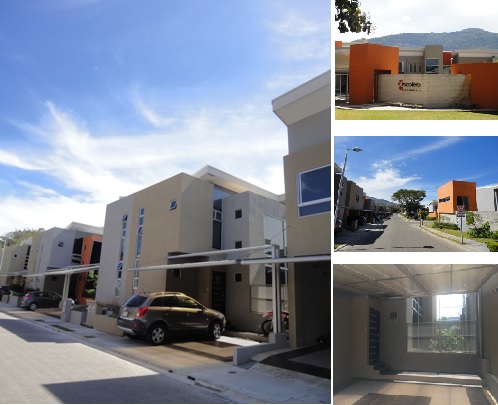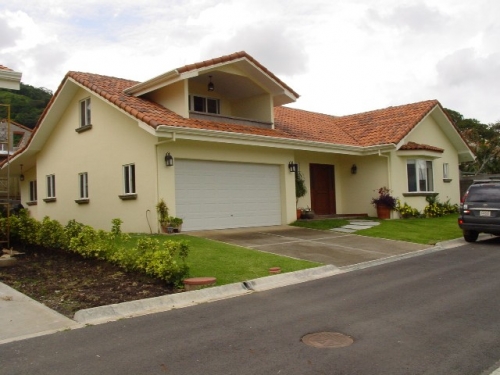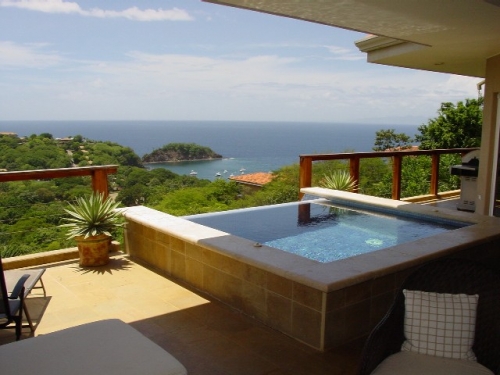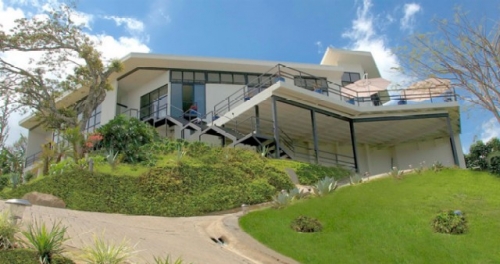Costa Rica Guide
Costa Rica Real Estate
List your property today!
Inclusion of real estate listings at Costa Rica Guide is
absolutely free of charge.
Featured Properties
Costa Rica Guide - Costa Rica Real Estate
FAQs - Costa Rica Country Profile
What is the climate like in Costa Rica?
Like many tropical countries, Costa Rica experiences two seasons: The rainy season and the dry season. The dry season (Summer) is generally from about late December through April. May and June represent a transition period as we move from summer to winter. July through October are the rainiest months of the year. What does this mean? It means that usually there are beautiful sun shiny mornings followed by heavy rains in the afternoon. This does not mean that we don't experience periodic days where it rains from sunrise to sunset, and/or several days of continuous rain, on the other side of the coin, it is not uncommon for us to experience days of sun with no rain. Traditionally in July we have the Costa Rican equivalent to an "Indian summer" in Costa Rica we can it the "veranillo de San Juan" means Saint Johns little summer. This generally takes place around the second or third week of July.
When is the best time of year to visit Costa Rica?
The best time of year to come to Costa Rica depends a lot of what you want to do while you're here. Our busiest time of year is the dry season which is late December through April. The advantage to travel during this time of year is that the weather is usually at its best. The disadvantage is that there are a lot of people traveling at that time, therefore, it is necessary to be sure to have previous reservations at the hotels you are interested in visiting. Travel in the rainy season, means that you must bring your rain gear and be prepared to use it with a smile. The advantage is that prices are normally lower, crowds are usually greatly reduced, professional naturalist guides are more readily available, and the opportunity to take advantage of some very special natural occurrences that take place such as the Atlantic Green Sea Turtle nesting season June through September in Tortuguero National Park.
What should we bring for a general natural history trip to Costa Rica?
- Sunscreen and insect repellent
- Casual clothing for traveling in cities
- Shirts-cotton, long and short sleeved Sweater or jacket
- Trousers-cotton hiking pants or lightweight hiking boots, thongs or sandals, river sandals or any kind of shoes that can get wet and straps onto your feet.
- Shorts for hiking and relaxing
- Socks-bring extra in case feet get wet
- Rain gear-poncho, raincoat, and/or umbrella
- Hat(s)-with visor for rain and sun protection
- Plastic water bottle-especially for hikes
- Flashlight with spare batteries and bulb
- Binoculars, field guides
- Swimsuit
- Plastic bags for wet cloths
- Towel
- Sunglasses and croakies
Tipping. When and how much?
Restaurants are required by law to add 10% tax and 10% tip to the bill. As a general rule, Costa Ricans do not tip.
Taxi cab drivers are not usually tipped unless extra service is provided.
Bellboys are often tipped a minimum of US $1.00 up to US $1.00 per bag, at check in and check out. Remember that the people that carry luggage at out-of-town places are bellboys too, even if they are not sporting the normal bellboy attire.
Chamber maids are so often overlooked. We think they are among the most important people to tip. You may want to consider US $0.50-1.00 per night.
Are credit cards widely accepted in Costa Rica?
Visa and MasterCard are widely accepted. AMEX and Diners Club are accepted in select locations. When using your credit card you are charged with the official exchange rate in Costa Rican colones.
Should we take our travel insurance?
Yes !!!
However fit and healthy you are, do take out medical insurance, preferably one with provisions for flying you home in an air ambulance in the event of an emergency. Here in Costa Rica we have excellent medical care and if you were to get sick or have some kind of an accident while traveling. Nevertheless, while much more reasonable than in the US, medicine and treatment here can be expensive therefore we highly recommend insurance.
Should I bring my own bottled water?
No it is not necessary to bring water from your home. Water is usually safe in San Jose and the highlands. Where you have to be the most careful is on the coasts. Bottled water is also readily available at most hotels as well as corner stores, and super markets.
Is it safe to rent a car? Is it safe to drive at night?
In the past there have been repeated incidents of rented cars being broken into and a few cases of bandits flagging down cars and assaulting the occupants. Rented vehicles are identifies by special license plates and a sticker therefore becoming an easy target. So to answer the question, no it is not safe, but preventive measures can insure your safety and the vehicles. When in San Jose always park the car in a parking lot and never leave suitcases, camera equipment, jackets or anything interesting in the car. When out of town be sure to ask at the hotels if their parking lot has a guard and if not where the safest place to leave it is. As far as driving at night goes, the Caribbean side is the place where there have been the most problems. These have taken place on the road which goes through Braulio Carrillo National Park and on the road that goes from Limon to Cahuita. To date we have not heard of this happening anywhere else. If you apply the same rules as you would in an area of questionable security in the United State you shouldn't have any trouble.
- Get off the road and to your next overnight station as early as possible.
- Don't stop for anyone flagging you down on the road
- If a traffic cop wants to give you a ticket, take the ticket, don't offer a bribe or hand out any cash as "payment" for the ticket.
What are road conditions like?
In Town
San José is notorious for its narrow streets, complicated one way
grid system, heavy traffic and crater like pot holes. Familiarity
with a San Jose road map ahead of time can be quite helpful. Be
sure to talk to your hotel receptionist or car rental agent before
you go so that you are as oriented as possible before you venture
out. Also be aware that here in San Jose we give directions by using
land marks such as "From the Strangler Fig (we all know which strangler
fig they're talking about)100 meters north and 200 meters east"
When this happens ask the person if they can give you the address
by streets "calles" and avenues "avenidas". Most of the time they
will be able to tell you, but sometimes people just don't know what
the street address is. We really didn't start to learn how to give
addresses this way until we started giving addresses to foreigners
who had no way of knowing where the Strangler Fig is, where Matute
Gomez' house is, what Pulperia La Luz is and which one of the 100
churches in San Jose they are talking about. Also sometimes when
they say 100 meters or 100 varas they mean one block, 200 meters
or varas is two blocks and so forth.
Outside of San Jose
While on the panamerican highway, the road is in generally good
condition by Costa Rican standards. For the most part the highways
are two lane highways. There are the inevitable pot holes, and the
lanes are narrow. For the most part roads have many curves, be prepared
for big buses and trucks passing on blind curves. Fog is also quite
common on some of the mountain passes. During the rainy season landslides
are often seen both on the highway and off. The roads that branch
off of the highway to go to Monteverde or the beaches for instance
vary in quality. There is everything from gravel and dirt roads
that are passable to really difficult to negotiate back country
roads. It is best to ask your car rental agent, the hotel you are
going to, or your travel consultant about the conditions of the
road before you head out. Always be prepared for cyclists, pedestrians,
a broken-down vehicle or even an ox-cart around the next bend. Many
foreign drivers complain that the roads are inadequately signposted.
This is often true, so try to get hold of a decent road map and
ask locals if you are not sure. Costa Ricans are nearly always able
and willing to help.
What documents are required to enter Costa Rica?
Citizens of all nations require at least a passport to enter Costa Rica. Passport-carrying nationals of the following countries are allowed 90 day stay with no visa: Most western European countries, Argentina, Canada, Colombia, Israel, Japan/ Panama, Romania, South Korea, UK, USA, Uruguay.
What are the good night life spots?
Cosmopolitan San José has a wide variety of restaurants- something to satisfy most tastes and budgets.
Restaurants
Costa Rican Food.
- The best-known one is the La Cocina de Leña (tel. 223-3704,255-1360) in the El Pueblo Shopping Center. The restaurant's name literally means "the wood stove" and the atmosphere is that of a cozy country kitchen.
- Another up market place with good Costa Rican food in a rustic setting is Tiquicia (tel. 289-5839). Located in a farm house up in the hills of Escazu, this restaurant gives diners great views and sometimes has live local music. Call first for reservations and directions.
- Bihaua is owned by a famous Costa Rican cook. This restaurant is said to serve "nouveau Costa Rican cuisine"
- La Fiesta del Maiz is only open on weekends, but serves every variation of corn you can imagine, this is a favorite of Costa Rican locals
- Chelles is an all night bar, restaurant which is quite famous among the locals as the "last stop" before going home.
Sea Food
- Rias Bajas
- Lobster Inn
- El Banco de Los Mariscos
Beef
- La Cascada
- El Chicote
- Los Anonos
- Los Antojitos
Italian
- Pasta Factory
- Il Bagatto
- La Piazetta
Do we need to make reservations in advance?
If you intend on traveling during the high season (December through April), and you want to stay at very specific hotels you should plan do your best to make reservations as much as six months in advance. This is not to say that if you wait until two months prior to your traveling time you won't be able to make reservations, you will be able to find space, it just may not be exactly at the hotels you originally wanted, and if a guide is important to you it may difficult to get one.
Are the charter planes safe?
Statistically, you are safer flying in a single engine charter plane than you are riding in a vehicle on the highway.
The above FAQ is courtesy of Costa Rica Expeditions






